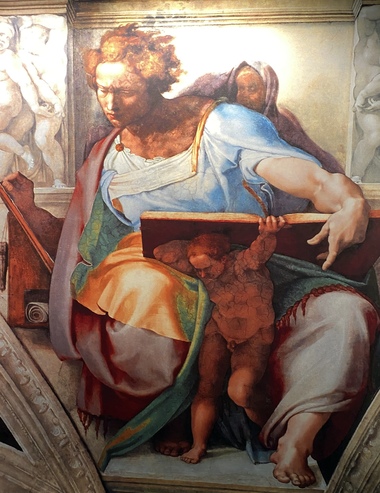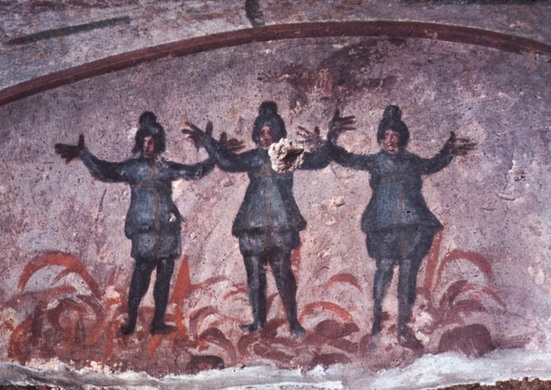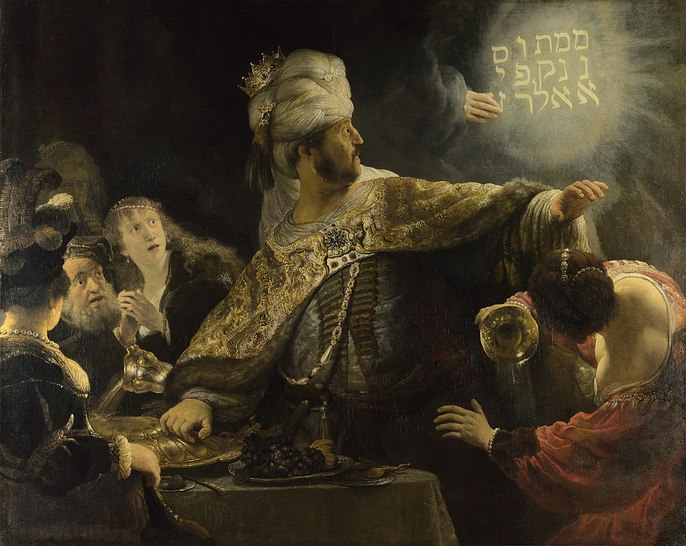
Michelangelo, 1508-1512, Sistine Chapel Ceiling, Rome
Content created: 2018-05-10
File last modified:
The biblical Book of Daniel, of unknown authorship, collects anecdotes from the life of a Judean exile named Daniel, who putatively lived during the Babylonian Captivity (from 586 to 539 BC). In these stories, Daniel is handsome, clever, articulate, and possibly of royal blood. He also has the gift of prophecy and the interpretation of dreams, and he rises to become an advisor to the pagan king. His life, from about 605 until about 540 BC, is recounted in chapters 1-6 and his prophecies in chapters 7-12, virtually all of them rather pointedly foretelling the fall of empires (such as, for example, the Babylonian one holding him as an exile).

The stories associated with Daniel seem to have been told, and possibly written, for some centuries before the composition of the text that survives. Most scholars argue that the text we have today was probably composed between 167 and 164 (about three centuries after Daniel is supposed to have lived), when Hebrews were experiencing strong pressure to accommodate themselves, willy-nilly, to the strongly Greek dynasties governing them following Alexander’s conquests in the 300s. For one thing, the text is filled with historical inconsistencies. For another, both the prophetic predictions of the fall of oppressive governments and the heroic figure of the noble Daniel would have been especially relevant in the political moment of the mid-second century BC. (The prophetic chapters have been mined ever since by religious people looking for predictions of everything from medieval plagues to American elections. These chapters will not concern us here.)
Daniel’s colorful life has inspired artists and storytellers for centuries, and paintings of three incidents in particular can be found in art museums across Europe and the Americas:



Two additional stories constitute chapters 13 and 14, and come close to being prequels to the action of the main chapters. They present Daniel as a sort of teen-age detective. Chapter 13 is usually called “Susanna and the Elders.” Chapter 14 is called “Bel and the Dragon.” These two stories may or may not have been included originally with the rest of the Book of Daniel —most likely not.
Although missing from known Hebrew and Aramaic versions of the Book of Daniel, the “Susanna” and “Bel” stories nevertheless appear to be equally old and equally popular Hebrew tales, since they appear with the rest of the Daniel in the Septuagint, the ancient Greek translation of the Hebrew Scriptures done between the mid-200s and mid-100s, B.C. (Click here for more on the Septuagint.) Hence, our earliest extant versions are in Greek. Today chapters 13 and 14 are included in Bibles used by Roman Catholic and Eastern Orthodox Christians, but are excluded from Jewish and Protestant Bibles.
Both “Susanna” and “Bel” present Daniel as a prescient young detective dedicated to truth and virtue. In the first, the pious young Daniel exposes evil Hebrew elders driven by lust; in the second he exposes evil pagan priests given to greed and gluttony. (It is hard to avoid the suspicion that the unflattering presentation of the Hebrew elders and their implied similarity to the corrupt pagan priests may have had some influence on which faith traditions included or excluded these two stories from their canons.)
“Susanna” has inspired countless works of Western Art —not impossibly because it provided an opportunity to paint a naked lady while ostensibly producing a pious religious work— and that story is presented in full here. “Bel and the Dragon” will be briefly summarized afterward.
The basic public-domain translation used here comes from an archive at www.sacred-texts.com, but I have taken substantial liberties with it in order to eliminate conspicuously tortuous or archaic language, obsolete punctuation, and occasional misleading wording. Line numbering corresponds with other translations, but chapter divisions and summaries have been inserted. (For the Greek text, click here.)
Review quizzes are available for this reading:
24 questions arranged in four "wimp" versions:
1,
2,
3,
4
24 questions arranged in two normal" versions:
1,
2
24 questions arranged in a single "hero" version:
1
Background Design: Hebrew Lines From the Book of Jonah